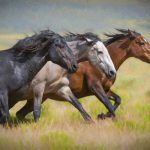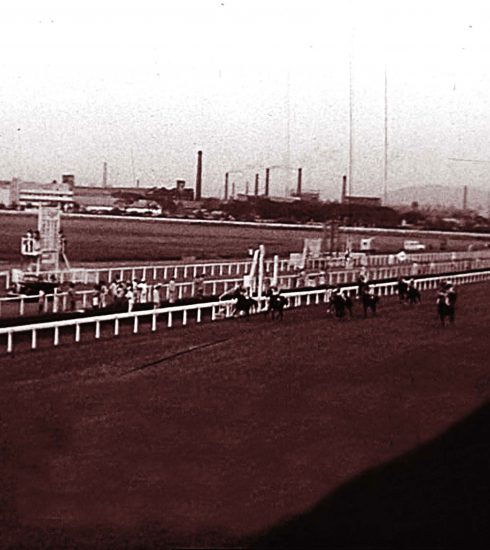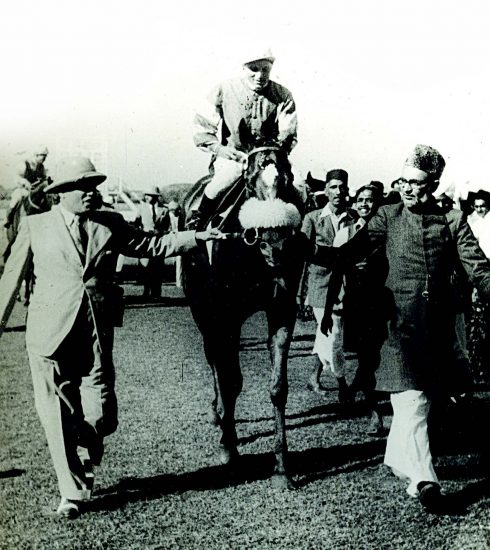BRAVO The Conqueror of the great Carbine
BRAVO
The Conqueror of the great Carbine
In the fifty years straddling the turn of the 19th century, several horses who had performed conspicuously abroad came to India to race. Thus we had one winner of an English Classic, several winners of the Irish Classics including winners of the Irish Derby and some winners of the Melbourne Cup. One amongst the last category was a horse called Bravo who won the 1889 Melbourne Cup beating the redoubtable Carbine.
Bravo was a light bay bred near Braidwood in New South Wales. In appearance, he was very much like his sire – Grand Flaneur – who had won the Melbourne Cup in his time. He was a precocious two year-old and running in the colours of Mr. W.E. Royd, he won half of his dozen starts, was the runner-up on one occasion and placed third twice, including in the AJC Trial Stakes at Randwick. He was among the 56 Sydney entries for the 1886 Melbourne Cup. Allotted just 6-6, he figured in ‘Top Ten’ of the well-known scribe “Warrior” when the weights were declared.
He commenced his second year of racing towards the end of August running third in a field of 29 runners to Rosebud and Ellington in the AJC Spring Handicap of a mile and a quarter. A month later, he was unplaced in Bohemian’s Metropolitan Stakes (2 m.) but the following day won the AJC Members’ Handicap (9 f.) with Martin Gallagher in the saddle. Incidentally, Bohemian was later bought by the well-known Teddy Weekes and came to India.
Now it was on to Flemington, Melbourne for Bravo. He was, as reported, in ‘top buckle’ and he ran on all four days of the Spring Carnival. On the opening Saturday, he was three lengths off the dead-heaters Isonomy and Boolka in the VRC Melbourne Stakes over a mile and a quarter. Despite his low-weight, he was not among the fancied runners for the Melbourne Cup run on Tuesday and he was never prominent in Arsenal’s race. On Thursday, he finished third to Lord Wilton and Remus in the VRC Spring Handicap (10 f.).Then, on the closing Saturday he ran a splendid and gutsy race to win the mile and three quarter VRC Handicap by a neck from The Britisher. Four races within a week over a distance of six miles and a quarter would be an unthinkable rigour for modern horses. It was, however, quite the par in those days. Horses were meant to run and they were made to run if they could be got to the post.
Overall, Bravo had acquitted himself creditably in his first appearance at the Victorian Spring Carnival and he found an ardent admirer in the Melbourne stock broker Mr. W.T. Jones who bought him for 1,000 gns., a high price at that time. Mr. Jones had originally come from Ballarat and it was to trainer Thomas – popularly known as Tommy – Wilson that Bravo went. It was rumoured that Mr. Martin Loughlin took half a share in the horse but his name never figured on the race cards. Whether it was the Victorian climate or some aversion to Dowling Forest where Tommy Wilson’s string was based it is difficult to say. What is certain is that the once sound-as-a-bell Bravo was never the same horse physically again. To begin with he had so severe an inflamation of the bowels that the vet Marsden feared that he could not be saved. Then, his hoof started troubling him. Add to that his tendency to develop curbs in wet and cold weather which required constant blistering. Tommy Wilson was nothing if not a patient trainer and he nursed Bravo through all these travails and the horse was duly entered for the 1887 Melbourne Cup. As the spring came around, Bravo was back in work and glowing reports began to emanate from Dowling Forest. Not for long, though, as Bravo’s hoof once more started becoming troublesome. He was scratched from his spring engagements and was in Dowling Forest when Dunlop won the 1887 Melbourne Cup.
So bad was Bravo’s hoof that in May 1888 a columnist referred to it as “cancerous”. Such was his prowess, though, that he was again entered for the Melbourne Cup and by August seemed to be well within himself. That very same columnist, after a visit to Tommy Wilson’s establishment wrote – “Bravo sweats freely and his foot is all right again. Should it stand, his owner may have then satisfaction of leading him a winner in the coming season.”
Wilson was confident of winning the Caulfield Cup that year either with Oakleigh or Bravo. The former was the first choice but after the Ballarat party was forestalled in the betting, Bravo became the chosen one. In the short time that it took the horses to reach the post after leaving the paddock, the Ballarat party got close to 30,000 pounds on their horse, most of it each way. That hedge saved Wilson’s camp for Bravo, though he ran a great horse as was the saying of the day, could only finish third to Chicago and the Maorilander mare Spade Guinea. It was widely believed that Gorry on Bravo had ridden a bad race and that belief was strengthened when it was later reported that Gorry and Sanders – the rider of Spade Guinea – had exchanged blows in the Jockeys’ Room, Sanders being fined 2 pounds for initiating the ruckus.
When Bravo stepped onto the main track for the Melbourne Cup, astute watchers noticed that he moved stiffly. His canter to the post was pleasing enough and he ran a prominent race all through, moving nicely along the Salwater River stretch, getting into a good position by the time the abbatoirs were passed and challenging the one-eyed Cyclops who piloted the field into the straight. The challenge was short-lived. Cyclops kept going to finish fourth to Mentor, Tradition and The Yeoman. Bravo, too, plugged on and was sixth, just ahead of his Caulfield conqueror Chicago.
As in his first appearance at the Victorian Spring Carnival, Bravo reserved his best for the closing day. He once again won the VRC Handicap over a mile and three-quarters beating The Yeoman – thus reversing the Melbourne Cup form – Chicago, 1886 Melbourne Cup winner Arsenal who was the favourite and other good horses like Ben Bolt, Mara, Enfilade and Blue Mountain. Then came a bit of a mystery with Bravo becoming the property of Mr. Martin Loghlin and moving into the yard of R. Clifford. R. Clifford was the racing name of R. McKenna, a noted ‘India Buyer’, known quite inexplicably in Calcutta as “Shitty Dick” McKenna. When Bravo faced the starter for VRC Standish Handicap over six furlongs on 2 January 1889, the race-cards showed him once again as the property of Mr. W.T. Jones. The interregnum was, perhaps, a transaction dissolving the undisclosed partnership.
Eye-brows would certainly be raised today to see a horse like Bravo running in a sprint like the Standish Handicap. That, however, was the norm in those days. Just as horses were run far too often, they were also run over a very wide range of distances. Just two months later, Lochiel and the great Carbine ran in the six-furlong Newmarket Handicap. What’s more, they were not just out for an outing. Lochiel finished second and Carbine third. Three days later, the pair contested the Australian Cup over two miles and a quarter when Lochiel again defeated Carbine with Bravo finishing in the ruck.
When Bravo had moved to his winter quarters at Dowling Forest, his owner Mr. W. T. Jones was in England and Tommy Wilson received a cable asking him to prepare Bravo to be sent to England. This was the period when the Aussies, led by Hon. James White, had launched their “Operation Home Country”. What had occasioned Mr. Jones’s cable was perhaps the victory of the Australian horse Ringmaster. Ringmaster later flopped at Royal Ascot and Mr. Jones sent another cable. This time it said “As you were”.
Bravo wintered well and Tommy Wilson was even more sanguine of winning the Caulfield Cup this time around. For the second year running, Bravo was backed heavily by the Ballarat crowd and once again Bravo could finish only third, this time to Boz and The Charmer. Once again, the jockey came in for much criticism, it being almost the consensus that O’Brien had kept the son of Grand Flaneur way off the pace. The Melbourne Herald racing correspondent wrote – “Bravo may perhaps be better served by longer distance and lighter weight, for he has 5lbs off his back in the Cup. He ran respectably, and it would not be astonishing were he to gain a place in Melbourne Cup.”
What that correspondent was probably not aware of was that while returning to his stable after the race, Bravo had stepped on a beer bottle and bruised his leg badly. He was dead lame when Wilson inspected him the following morning and the trainer, utterly despondent, took him back to Ballarat. The news spread like wild fire and Bravo’s odds for the Melbourne Cup began to drift alarmingly. At 200 to 1, one Mr. Phillips backed him to win 10,000 pounds. At 1000 to 1, Mr. W.C. Cullen put his ten quid with the penciller Lawrence Zucker. These, however, were isolated wagers. There was a coterie of the “know-all” ilk which maintained that Bravo’s injury was either faked or highly exaggerated just to obtain better odds.
Significantly, their knowledge was flawed or their courage found wanting for none of them took the fancy odds when they were available.
All this while, Bravo had his foot poulticed and he never left his box. It was only on Thursday before the Melbourne Cup that Bravo finally put his foot on floor. On Saturday, still at Dowling Forest, he was walking without discomfort and he was given a swinging canter over a mile and a quarter on Sunday afternoon before being taken to Melbourne on Monday, the day before the Cup.
The 1989 Melbourne Cup had twenty runners, a field smaller than usual. Quality, though, was not wanting. Carbine was the top-weight assigned 10-0 with Bravo at 8-7. The unsteady favourite was Melos with Chicago next in demand; then a big jump to Carbine and Bravo at 10s. (The bet of Mr. Phillips had brought Bravo back into the market for the bookmaker concerned began to lay off to reduce his liability). Melbourne turf scribe ‘Asmodeus’ found Bravo very quiet during his saddling and after he had seen the horses in the paddock, he declared that Carbine, Melos, Benzon, Chicago, Singapore and Bravo looked ‘cherry ripe’.
After two attempts, the starter Mr. George Watson got them off to a capital start and for the first furlong they came forward like a squadron of cavalry. Then Singapore showed out in front till Carrington took over passing the Judge for the first time. Melos, Carbine and Bravo were in middle group as the order kept changing upfront with Carrington giving way to Anteus and Singapore, Rudolph, Chicago and Benzon keeping the tabs. As they passed the abattoirs, the principals began a slight but perceptible move forward. Carbine on the rails and Bravo next to him made swift progress. Not so with the favourite Melos who got chopped every time he made his move on the outside.
It was Chicago who was greeted with the thunderous roar that heralds the entry of the field into the straight for the final run-in. Carbine, making his run on the rails (with his crushing impost of 10 st. the jockey wanted to travel not a centimeter more than was required), had a dream run and at the distance he joined Chicago. At this juncture Chicago, running out of puff, began to veer out and this presented James Anwin the gap to go through. There was a brief tussle till the weight on Carbine told and Bravo won far more easily than the length verdict suggested. Melos, much buffetted from the abattoirs to midway up the straight, finished third.
Twenty year-old James Anwin was essentially a riding boy in Tommy Wilson’s stable who had ridden a few winners in up-country meetings and had won the VRC Handicap on Bravo in 1888. This Melbourne Cup win was like manna from heaven. Mobbed by the Press after he had weighed-in, he was elated but not ecstatic. The scribes were disappointed when he failed to provide them with fodder for their columns. He said that it was an uneventful race; that his horse was a bit sluggish in the beginning but once he was spurred as they entered the Saltwater River stretch, he came into his own. His only worry was when going through gap between Carbine and Chicago. He never used his whip and never thought that he needed it. He knew the horse and the horse knew him. For a young boy who had won the Melbourne Cup on his very first ride in the race, it sounded so bland. The owner Mr. W. T. Jones was not present being still in England but he ensured that Anwin was given a present of 500 gns. Anwin also received the Golden Whip – an annual award made by Mr. P.H. Reynolds to the jockey winning the Melbourne Cup.
To put Bravo’s performance in its proper perspective, it has to be mentioned that he was receiving a stone and a half – about 12 kgs. – from Carbine, that great galloping son of Musket. Carbine won the Melbourne Cup the following year carrying 10-5 and beating Highborn (6-8) by three lengths. Highborn twice won the Viceroy’s Cup after coming to India. Many knowledgeable people reckoned that until Phar Lap – another New Zealand-bred – came along, Carbine was the epitome of a racing machine.
Shortly afterwards, Bravo was sold to Mr. J Cripps (of Boz fame) for 975 gns. In the late autumn of 1890, there were enquiries from Mr. Baldwin of California – he was attracted by the three lines of Touchstone and two Bay Middleton in the horse’s pedigree – for services of Bravo as a stallion. The negotiations, however, did not go through. Then, in mid-May, Bravo was bought by jockey-cum-trainer W. Southall through M/s W.C. Yuille & Co. for 1300 gns. Southall was acting on behalf of the Indian owners M/s. Apcar and Gaspar. Thus was Bravo India-bound.
Towards the end of June, 1890, Bravo sailed for India aboard S.S. Onehunga. He was accompanied by jockey M.J. “Mo” Trahan who had made his name as a fine rider, his association with Commotion being only too well known. Trahan remained for long – over 40 years – in India, first as a successful jockey and after his riding days were over as a trainer. Bravo, on the other hand, just about saw the year out.
A rumour about his death soon after landing in India breezed through Bourke’s Bazzar in Melbourne. It was not true, of course. The whisperings that his old leg was troubling him again, however, had much credence. It took all of Southall’s skill to get him racing fit and to the post for the Viceroy’s Cup – the very raison de etre for his purchase – of 1890. Though the favourite for the race, all he could manage was a third behind Myall King – winning his third Viceroy’s Cup – and bracket-mate Moorhouse. That wasn’t all. Bravo returned from the race practically lame. Some time later, when a blister was being applied, he reared up, fell on his back and died on the spot.
For a horse who went through much of his racing career on three legs, Bravo certainly achieved much more than most sound horses do. He won a Melbourne Cup beating the legendary Carbine. No other horse ever did that!
– Major S. Nargolkar (Retd.)
AUGUST – SEPTEMBER 2008












